| dc.description.abstract | There are important changes in tenure arrangements and
practices since 1975 but with mixed performance. Among the positive
attributes of these changes is the simplification of the complex tenure
systems as compared to the pre-1975 period albeit questionable if
such level of homogeneity has a desirable mix of tenure arrangements.
A large segment of the farm population is able to access and operate
land. There is a broadening of the land distribution of the country by
shifting the concentration of landholdings towards the middle and
lower-sized farm categories. There are incremental policy changes
that include transfer land to heirs, titling of use rights, and relaxing
restriction on rental markets in some regions. The constitutionality of
some of these changes is, however, questionable since the 1995
constitution still prohibits any transfer of land other than through
state mandated institutions.
On the other hand, there are increasing numbers of small-sized
farms. Some of these are uneconomic in size. There are growing
numbers of rural households with no access to government allocated
land ("landless"). Insecurity of land and tree tenure effectively
reduces rights in land, reduces incentive to invest in land and grow
perennial crops, and limits growth in rental markets. There is also
evidence of a widespread breakdown in common property tenure
arrangements such as common grazing and forestlands for lack of
effective institution to economize on and efficiently use these
resources. The residence requirement for having and maintaining
access to government allocated land fragments land markets and
restricts migration as a strategy for diversifying income and pooling
risks, and easing pressure on land.
The history of land policy sequencing since 1975 has been
guided by an unbalanced policy framework with heavy emphasis on
equity through administrative-based land allocation. A preferred path
of policy development would have been to allow multiple channels of
acquiring land, strengthen security of tenure and rights in land,
promote rental markets as a main market-based mechanism, foster
effectiveness of indigenous institutions to economize on scarce land
resources in the commons, set norms and regulations for protecting
fragile ecosystems, encourage labor mobility, and enhance
development of factor markets in a context of broad-based
agricultural and rural development. Public policy has an important
role in the future, but it needs an informed and balanced view that
emphasizes on searching for equitable but efficient and sustainable
tenure arrangements that are mediated through the market place. | en_GB |


